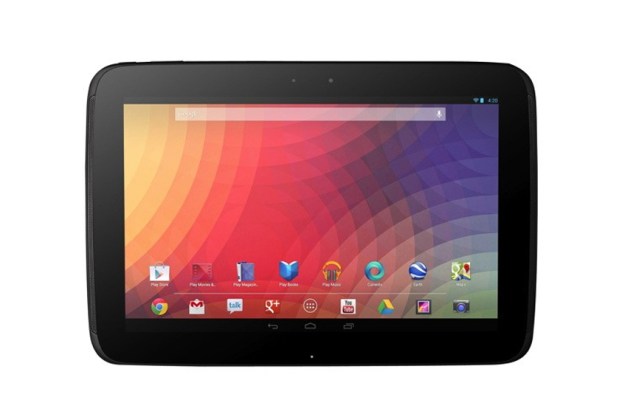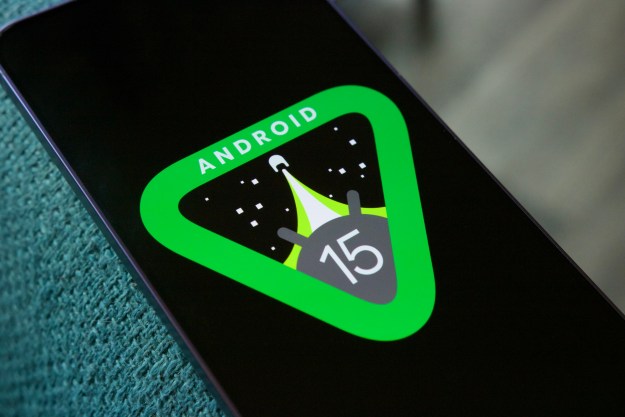
“Though battery life and processing power take a slight hit due to the insane pixel count of its screen, the Google Nexus 10 is the best 10.1-inch Android tablet we’ve ever used. If you can live with the lack of tablet-optimized apps on Android, this $400 tablet is the second-best deal on the market, topped only by Google’s Nexus 7.”
- Highest resolution of any tablet
- Android 4.2 UI is fast and easy to use
- Pure Android experience means you’ll get updates
- Comfortable to hold
- No microSD or expanded storage
- Battery life lower than competitors
- Google Play Store lacks tablet apps
The Motorola Xoom marked the arrival of Android tablets almost two years ago, but since then, the space hasn’t had many success stories. We’ve seen dozens of 10.1-inch tablets from the likes of Samsung, Asus, Acer, Toshiba, and others, but few of them have sold well, and as a result, the Google Play Store still doesn’t have many apps that cater to big screens. To fix this situation, Google is finally diving into the tablet market. This summer, it released the smaller Nexus 7, and it’s selling well. Now, for $400, it’s offering the Nexus 10, which has the highest resolution screen of any tablet and boasts a pure version of Android 4.2. Is it worth the cash, though?
Design and feel
If you can’t tell from looking at it, or from the logo on the back, Google designed the Nexus 10 in conjunction with Samsung. It was a smart choice. Samsung has been hellbent on creating the thinnest, best-looking, most-iPad-like tablets on the market. It’s done such a good job that Apple has sued it in a number of countries, trying to get its Galaxy Tabs banned from sale. With the Nexus 10, Samsung has kicked its game up a few notches.
The Nexus 10 is thinner and lighter than the iPad 4 at only 8.9mm thick (vs. 9.4mm) and a weight of 603g (vs. 652g). More importantly, it’s as comfortable to hold as a 10.1-inch widescreen tablet can be. We’re still not huge fans of this size, as it’s too wide when held in a landscape (horizontal) orientation and too tall when held in portrait. Still, for those of you who want a tablet roughly the size of a full iPad, but don’t want an iPad, you’ll find none as comfortable to hold as the Nexus 10. The unibody shell has been covered in a soft, rubberized coating, which helps you keep a good grip of the tablet and also helps it lean up against something, if you’re hoping to watch video.

A headphone jack and Micro HDMI port are located on either side of the tablet when held in landscape, as are two stereo speakers. The Nexus 10 doesn’t quite match the clarity of sound that comes from the iPad, but its speakers certainly outperform many other tablets on the market. If you want to entertain a crowd though, you’ll need an external speaker.
The screen
Once you turn on the Nexus 10, the fun begins. This tablet has a 2560 x 1600 pixel LCD screen resolution. At 10.1 inches across diagonally, that gives it a pixel density of 300ppi (pixels per inch), which is far greater than the ‘Retina’ iPad’s 2048 x 1536 pixel screen, which tops out at 264ppi. Number crunching aside, this screen is pretty and smooth. We cannot really make out individual pixels at all. Fonts, icons, everything looks smooth. Like the iPad, there are many apps that don’t yet have high-resolution icons, so they tend to look a little blurry due to their upsizing, but other content looks amazing.
As with any bump in screen resolution, the Nexus 10’s display does suck up some battery life and processing power, but we haven’t found it particularly damaging – more on that later in the review.
Operating system and apps
The Nexus 7 came with Android 4.1 (Jelly Bean), but we’re really enjoying Android 4.2 (still “Jelly Bean”). Though it was billed as an incremental upgrade, it adds some fun new features and a refined design. For starters, Google has finally ditched the odd docking clock and design of Android 3.0 Honeycomb in favor of a simpler, more smartphone-like experience for larger tablets, as well. (This new look was first shown on the Nexus 7).
The navigation buttons (Back, Home, Recent Apps) have been centered, which is good, but they can be tough to reach if you’re using the tablet in landscape. Similarly, there is now a row of docked icons on the bottom of the screen that you can customize, and the apps menu is now directly in the bottom center as well. Previously, it sat lonely in the upper right corner of the screen. Google has also re-emphasized its search bar, promoting it from its small upper left corner prison into a dominant strip along the top of the screen.
If you liked one pull-down notifications bar, how about two? Google has added a second pull-down bar. If you pull down on the left side of the screen, you’ll get your standard notifications, but pull down from the right side and you’ll get some quick settings, so you can easily toggle things like Bluetooth, Wi-Fi, Airplane Mode, and screen brightness. Though many users will undoubtedly get confused when they keep pulling down settings when they want to see their notifications, but we think the new system works pretty well.
Android 4.2 also has an enhanced lock screen. If you so desire, you can add multiple widgets to the lock screen. We added a calendar and Gmail, but it appears that many installed widgets should work. It’s a small feature, but it works well. The addition of multiple user accounts is also nice for families that share a tablet.
Of course, we would be remiss if we didn’t, once again, point out the nagging problem with big Android tablets: the lack of apps. Even the Facebook app still isn’t formatted for large screens yet. The number of apps in the Google Play Store is edging toward a million, but outside of some games, few of these apps take advantage of large tablet screens. Instead, you’ll end up using apps that feel way too stretched out. To pull a line from Lord of the Rings, most apps are like butter scraped over too much bread. When you do find an app that’s formatted for tablets, like Netflix or Mint, you’ll know it. Because Apple requires that all iPad apps be designed from scratch for its tablet, there are roughly 300,000 apps available for it and they all are made with tablets in mind.
Having complained about the apps, we must say that for the first time, the Android tablet interface and design is extremely competitive with the iPad. Now we just need more apps.
Hardware specifications
The Nexus 10 is powerful. It packs in a dual-core 1.7GHz Samsung Exynos 5 processor, 2GB of RAM, 16GB or 32GB of internal memory (no microSD, sadly), a 5-megapixel rear camera, and a 1.9-megapixel webcam. NFC, Bluetooth, Wi-Fi, an accelerometer, GPS, microphones, and most everything else you’d expect is also included. And did we mention the 2560 x 1600 pixel LCD screen with Gorilla Glass 2? It’s nice.
As we said in the Droid DNA review, hardcore users will likely run up into a space wall due to the lack of microSD storage. If you like to watch a lot of HD content – which looks gorgeous on this screen, by the way – you’re going to be hard pressed for the space to store those movies.
We performed a Quadrant benchmark test and achieved a score of 4,100 to 4,500, which is decent, but not groundbreaking. The Droid DNA, for example, just scored 8,100 and the Galaxy S3 (another phone) scored about 5,000 in tests earlier this year. Still, the Nexus 10 is on the higher end of our tablet tests, and represents a slight step up from the 3,500 score of the Nexus 7. In the GL Benchmark Egypt Classic test for graphics, the Nexus 10 got about 49 frames per second. This isn’t as high as some devices, but it should still run most high-end games without too much trouble.
Cameras
If you’re into photography, don’t buy a tablet. The Nexus 10 has a decent 5-megapixel rear camera, but don’t expect to be blown away. In our testing, outdoor shots came out decent, but lacked detail. The shots you’ll see on the Web here probably look nice, but if you show them at a higher resolution, you’ll be left disappointed. Nighttime shots turned out a bit better. Google has improved its focusing in the dark. Instead of just snapping a pic, now the camera turns on the rear LED flash a second before it shoots, allowing it to actually focus instead of just blindly shooting in the dark – a problem that’s more common than you’d think. We also had some mild difficulty with reflective surfaces. When taking a few shots of our office kegerator, the Nexus had a tough time balancing the bright light from a mild reflection, washing out the entire photo. The iPad had similar trouble, but compensated better, producing a more balanced shot. This is just one of many examples where Apple’s camera still edges ahead.

We tried out the Photo Sphere capabilities of the camera, which allow you to stitch together photos 360 degrees around you. Unfortunately, we couldn’t get it to stitch together without obvious bugs and photo doubling. Included is a photo of a desk. There’s only one Coke can on it.
The 1.9-megapixel webcam works well. We had no difficulties with it.
Battery life
The Nexus 10 has a 9,000mAh battery in it, which is more than four times the size of an equivalent smartphone, but it’s massive, high-resolution screen eats up that battery fast. The iPad currently sets the bar at around 10 to 11 hours of life on moderate usage. Because of its fancy screen, the Nexus 10 is getting closer to 8 hours under normal usage. It idles well, however, and holds a charge when you’re not actively using it. If battery life is a top concern, this may not be the tablet for you, though it performed better than some early tablets.
Conclusion
Though battery life and processing power take a slight hit due to the insane pixel count of its screen, the Google Nexus 10 is the best 10.1-inch Android tablet we’ve ever used. This is how Google envisions an Android tablet, and we like it. If you can live with the lack of tablet-optimized apps on Android, this $400 tablet is the second best deal on the market, topped only by Google’s Nexus 7.
Highs
- Highest resolution of any tablet
- Android 4.2 UI is fast and easy to use
- Pure Android experience means you’ll get updates
- Comfortable to hold
Lows
- No microSD or expanded storage
- Battery life lower than competitors
- Google Play Store lacks tablet apps
Editors' Recommendations
- The Google Pixel 8a price just leaked. Here’s how much it’ll cost
- The best tablets in 2024: top 11 tablets you can buy now
- Best Google Pixel deals: Save on Pixel 8, Pixel Buds, and Pixel Watch
- Something strange might happen to the Google Pixel Fold 2
- What is NFC? How it works and what you can do with it












